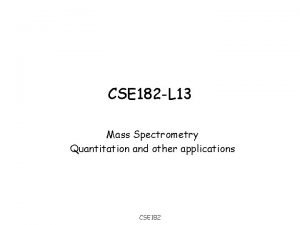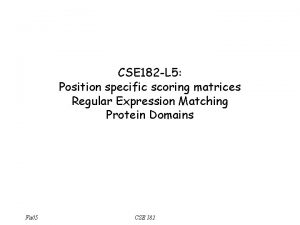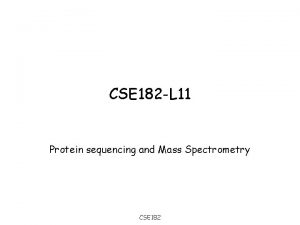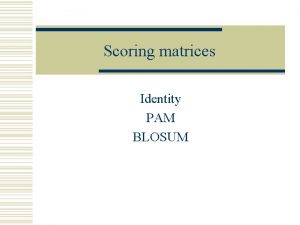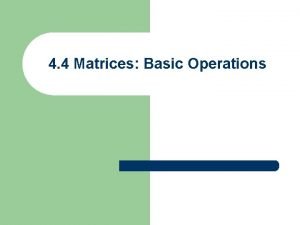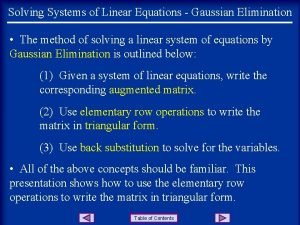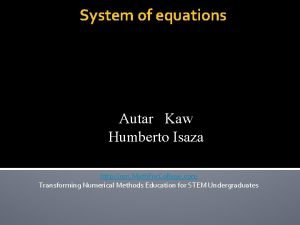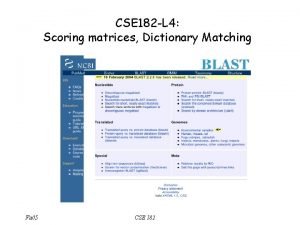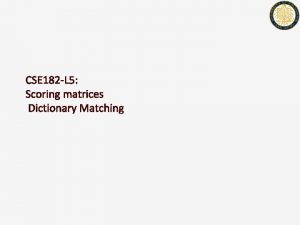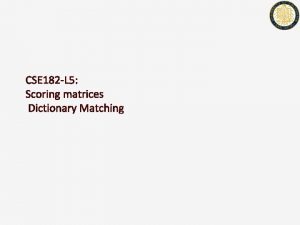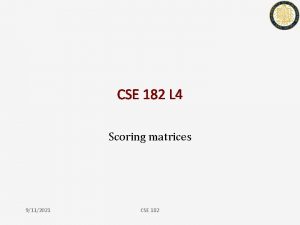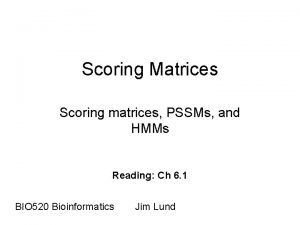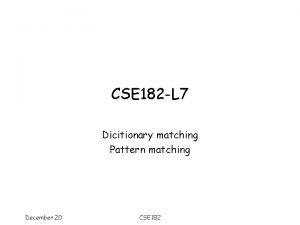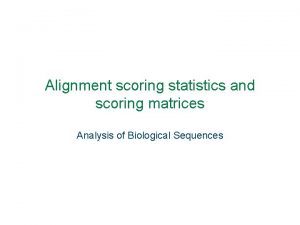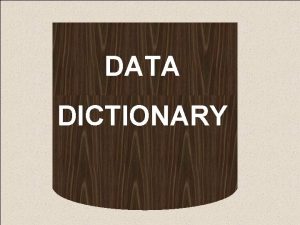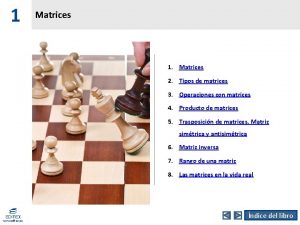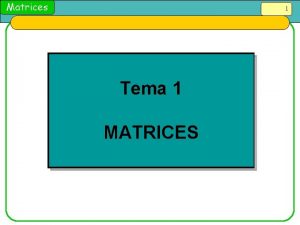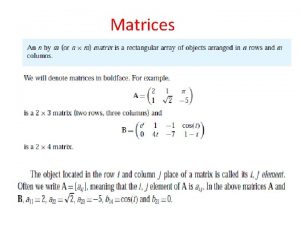CSE 182 L 5 Scoring matrices Dictionary Matching



















- Slides: 19

CSE 182 -L 5: Scoring matrices Dictionary Matching June 21 CSE 182

Expectation? • Some quantities can be reasonably guessed by taking a statistical sample, others not – Average weight of a group of 100 people – Average height of a group of 100 people – Average grade on a test • Give an example of a quantity that cannot. • When the distribution, and the expectation is known, it is easy to see when you see something significant. • If the distribution is not well understood, or the wrong distribution is chosen, a wrong conclusion can be drawn June 21 CSE 182

Scoring proteins • Scoring protein sequence alignments is a much more complex task than scoring DNA – Not all substitutions are equal • Problem was first worked on by Pauling and collaborators • In the 1970 s, Margaret Dayhoff created the first similarity matrices. – “One size does not fit all” – Homologous proteins which are evolutionarily close should be scored differently than proteins that are evolutionarily distant – Different proteins might evolve at different rates and we need to normalize for that 3 June 21 CSE 182

Frequency based scoring A B • Our goal is to score each column in the alignment • Comparing against expectation: – Think about alignments of pairs of random sequences, and compute the probability that A and B appear together just by chance PR(A, B) – Compute the probability of A and B appearing together in the alignment of related sequences (orthologs) PO(A, B) • A good score function? June 21 CSE 182

Log-odds scoring • Log-odds score makes sense. • It is also sensitive to evolution • However, to compute a log-odds score function you need good alignments • To get good alignments of sequences, you need a (log-odds) score function. June 21 CSE 182

PAM 1 distance • Define: Two sequences are 1 PAM apart if they differ in 1 % of the residues. 1% mismatch • PAM 1(a, b) = Pr[residue b substitutes residue a, when the sequences are 1 PAM apart] 6 June 21 CSE 182

PAM 1 matrix • Align many proteins that are very similar – Is this a problem? • 1 PAM evolutionary distance represents the time in which 1% of the residues have changed • Estimate the frequency Pb|a of residue a being substituted by residue b. • PAM 1(a, b) = Pa|b = Pr(b will mutate to an a after 1 PAM evolutionary distance) • Scoring matrix – S(a, b) = log 10(Pab/Pa. Pb) = log 10(Pb|a/Pb) 7 June 21 CSE 182

PAM 1 • Top column shows original, and left column shows replacement residue = PAM 1(a, b) = Pr(a|b) 8 June 21 CSE 182

• For closely related sequences (1 PAM) apart, we can make a set of alignments, and use that to compute an appropriate evolutionary distance. • What do we do for higher PAM sequences? June 21 CSE 182

PAM distance • Two sequences are 1 PAM apart when they differ in 1% of the residues. • When are 2 sequences 2 PAMs apart? 1 PAM 2 PAM 10 June 21 CSE 182

Generating Higher PAMs • PAM 2(a, b) = ∑c PAM 1(a, c). PAM 1 (c, b) • PAM 2 = PAM 1 * PAM 1 (Matrix multiplication) • PAM 250 – = PAM 1*PAM 249 – = PAM 1250 b a b c = a PAM 2 c PAM 1 11 June 21 CSE 182

Note: This is not the score matrix: What happens as you keep increasing the power? 12 June 21 CSE 182

Scoring using PAM matrices • Suppose we know that two sequences are 250 PAMs apart. • S(a, b) = log 10(Pab/Pa. Pb)= log 10(Pa|b/Pa) = log 10(PAM 250(a, b)/Pa) • How does it help? – S 250(A, V) >> S 1(A, V) – Scoring of hum vs. Dros should be using a higher PAM matrix than scoring hum vs. mus. – An alignment with a smaller % identity could still have a higher score and be more significant hum mus dros 13 June 21 CSE 182

PAM 250 based scoring matrix • S 250(a, b) = log 10(Pab/Pa. Pb) = log 10(PAM 250(a, b)/Pa) 14 June 21 CSE 182

BLOSUM series of Matrices • Henikoff & Henikoff: Sequence substitutions in evolutionarily distant proteins do not seem to follow the PAM distributions • A more direct method based on hand-curated multiple alignments of distantly related proteins from the BLOCKS database. • BLOSUM 60 Merge all proteins that have greater than 60%. Then, compute the substitution probability. – In practice BLOSUM 62 seems to work very well. 15 June 21 CSE 182

PAM vs. BLOSUM • What is the correspondence? • PAM 1 • PAM 2 Blosum 1 Blosum 2 • Blosum 62 • PAM 250 Blosum 100 16 June 21 CSE 182

P-value computation • • • BLAST: The matching regions are expanded into alignments, which are scored using SW, and an appropriate scoring matrix. The results are presented in order of decreasing scores The score is just a number. How significant is the top scoring hits if it has a score S? Expect/E-value (score S)= Number of times we would expect to see a random query generate a score S, or better How can we compute E-value? June 21 CSE 182

What is a distribution function • Given a collection of numbers (scores) – 1, 2, 8, 3, 5, 3, 6, 4, 4, 1, 5, 3, 6, 7, …. • Plot its distribution as follows: – X-axis =each number – Y-axis (count/frequency/probability) of seeing that number – More generally, the x-axis can be a range to accommodate real numbers June 21 CSE 182

• End of L 5 June 21 CSE 182
 Cse 182
Cse 182 Cse 182 ucsd
Cse 182 ucsd Cse 182
Cse 182 Blosum62 scoring matrix
Blosum62 scoring matrix Amino acid substitution matrix
Amino acid substitution matrix Script scoring action words
Script scoring action words Pg 167
Pg 167 Department order 182
Department order 182 Cessna 182 diesel
Cessna 182 diesel Flam 182
Flam 182 Cs 182
Cs 182 Tungsten-182
Tungsten-182 Engine on half power ahead - steer 182 degrees port side.
Engine on half power ahead - steer 182 degrees port side. Berkeley cs 182
Berkeley cs 182 Love 182
Love 182 Nosotros commands
Nosotros commands Subtraction of matrices definition
Subtraction of matrices definition Gauss elimination method example
Gauss elimination method example Can matrices be divided
Can matrices be divided Matrices in google docs
Matrices in google docs
